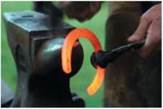
Concept explainers
A 0.40-kg iron horseshoe, just forged and very hot (Fig. 14-16), is dropped into 1.25 L of water in a 0.30-kg iron pot initially at 20 0°C. If the final equilibrium temperature is 25.0°C, estimate the initial temperature of the hot horseshoe.

Figure 14-16
Temperature of horseshoe
Answer to Problem 15P
Solution:
Temperature of horseshoe is 26.46 C.
Explanation of Solution
Given:
is the specific heat of iron which is 460 J/kgk
is the specific heat of iron which is 460 J/kgk
is the specific heat of water which is 4186 J/kgk
is the mass of iron horseshoe which is 40 kg
is the mass of iron pot which is 0.30 kg
is the mass of water
is density of water is 1000 kg/cu.m
is volume which is 1.25 L
is the temperature of iron horseshoe
is the temperature of iron pot which is 20 C
is the temperature of water which is 20 C
is equilibrium temperature which is 25 C
Formula Used:
The formula used is the relation between temperature and specific heat from thermodynamics
Where,
is the heat transferred
is the specific heat
is the mass
is the final temperature
is the initial temperature
From the formula above, the equilibrium temperature formula for calorimetry can be derived.
If two materials , and calorimeter with temperatures , and are in contact, then they will reach an equilibrium temperature .
This equilibrium temperature is given by equating the heat transferred by the three materials.
Equating the heat transferred is
This becomes
Where,
is the specific heat of material
is the specific heat of material
is the specific heat of material
is the mass of material
is the mass of material
is the mass of material
is the temperature of material
is the temperature of material
is the temperature of material
is equilibrium temperature
Calculation:
The mass of water is determined by the multiplying density with volume
Volume by the multiplying is 1.25 L. 1000 L is 1 cu.m. So 1.25 L is 0.00125cu.m.
Mass is now
kg
Inserting the given values in the equilibrium temperature formula for calorimetry:
C
Chapter 14 Solutions
Physics: Principles with Applications
Additional Science Textbook Solutions
Introductory Chemistry (6th Edition)
Campbell Biology (11th Edition)
College Physics: A Strategic Approach (3rd Edition)
Human Physiology: An Integrated Approach (8th Edition)
Microbiology: An Introduction
Concepts of Genetics (12th Edition)
- Using the Experimental Acceleration due to Gravity values from each data table, Data Tables 1, 2, and 3; determine the Standard Deviation, σ, mean, μ, variance, σ2 and the 95% Margin of Error (Confidence Level) Data: Ex. Acc. 1: 12.29 m/s^2. Ex. Acc. 2: 10.86 m/s^2, Ex. Acc. 3: 9.05 m/s^2arrow_forwardIn the Super Smash Bros. games the character Yoshi’s has a “ground pound” down special move where he launches himself downward to attack an enemy beneath him. A) If Yoshi flings himself downwards at 9.76 miles per hour to hit an enemy 10.5 m below him, how fast is Yoshi traveling when he hits the enemy? 1 mile = 1609 m B) How much time does it take Yoshi to hit the enemy beneath him?arrow_forwardNo chatgpt pls will upvotearrow_forward
- 1.62 On a training flight, a Figure P1.62 student pilot flies from Lincoln, Nebraska, to Clarinda, Iowa, next to St. Joseph, Missouri, and then to Manhattan, Kansas (Fig. P1.62). The directions are shown relative to north: 0° is north, 90° is east, 180° is south, and 270° is west. Use the method of components to find (a) the distance she has to fly from Manhattan to get back to Lincoln, and (b) the direction (relative to north) she must fly to get there. Illustrate your solutions with a vector diagram. IOWA 147 km Lincoln 85° Clarinda 106 km 167° St. Joseph NEBRASKA Manhattan 166 km 235° S KANSAS MISSOURIarrow_forwardPlz no chatgpt pls will upvotearrow_forward3.19 • Win the Prize. In a carnival booth, you can win a stuffed gi- raffe if you toss a quarter into a small dish. The dish is on a shelf above the point where the quarter leaves your hand and is a horizontal dis- tance of 2.1 m from this point (Fig. E3.19). If you toss the coin with a velocity of 6.4 m/s at an angle of 60° above the horizontal, the coin will land in the dish. Ignore air resistance. (a) What is the height of the shelf above the point where the quarter leaves your hand? (b) What is the vertical component of the velocity of the quarter just before it lands in the dish? Figure E3.19 6.4 m/s 2.1arrow_forward
- Can someone help me answer this thank you.arrow_forward1.21 A postal employee drives a delivery truck along the route shown in Fig. E1.21. Determine the magnitude and direction of the resultant displacement by drawing a scale diagram. (See also Exercise 1.28 for a different approach.) Figure E1.21 START 2.6 km 4.0 km 3.1 km STOParrow_forwardhelp because i am so lost and it should look something like the picturearrow_forward
 College PhysicsPhysicsISBN:9781305952300Author:Raymond A. Serway, Chris VuillePublisher:Cengage Learning
College PhysicsPhysicsISBN:9781305952300Author:Raymond A. Serway, Chris VuillePublisher:Cengage Learning University Physics (14th Edition)PhysicsISBN:9780133969290Author:Hugh D. Young, Roger A. FreedmanPublisher:PEARSON
University Physics (14th Edition)PhysicsISBN:9780133969290Author:Hugh D. Young, Roger A. FreedmanPublisher:PEARSON Introduction To Quantum MechanicsPhysicsISBN:9781107189638Author:Griffiths, David J., Schroeter, Darrell F.Publisher:Cambridge University Press
Introduction To Quantum MechanicsPhysicsISBN:9781107189638Author:Griffiths, David J., Schroeter, Darrell F.Publisher:Cambridge University Press Physics for Scientists and EngineersPhysicsISBN:9781337553278Author:Raymond A. Serway, John W. JewettPublisher:Cengage Learning
Physics for Scientists and EngineersPhysicsISBN:9781337553278Author:Raymond A. Serway, John W. JewettPublisher:Cengage Learning Lecture- Tutorials for Introductory AstronomyPhysicsISBN:9780321820464Author:Edward E. Prather, Tim P. Slater, Jeff P. Adams, Gina BrissendenPublisher:Addison-Wesley
Lecture- Tutorials for Introductory AstronomyPhysicsISBN:9780321820464Author:Edward E. Prather, Tim P. Slater, Jeff P. Adams, Gina BrissendenPublisher:Addison-Wesley College Physics: A Strategic Approach (4th Editio...PhysicsISBN:9780134609034Author:Randall D. Knight (Professor Emeritus), Brian Jones, Stuart FieldPublisher:PEARSON
College Physics: A Strategic Approach (4th Editio...PhysicsISBN:9780134609034Author:Randall D. Knight (Professor Emeritus), Brian Jones, Stuart FieldPublisher:PEARSON





